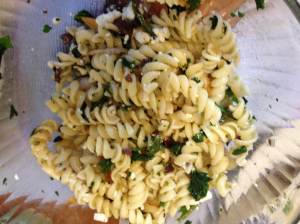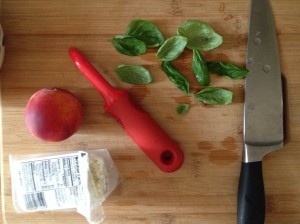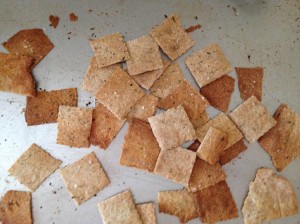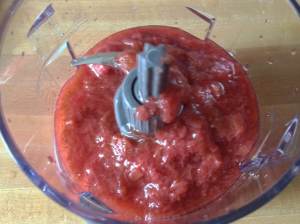Here’s the deal. A lot of my ideas were thought up long before I decided to start a blog. Which means there’s often no photographic evidence and almost no exact measurements. So, I propose you use your imagination on a lot of this. Like reading a book! (I’ll get better, I promise.)
Now that we’ve got that settled, let’s talk ramps. Some call them wild leeks or wild onions. They’re one of the most tender of the onion family, and they’re one of the first signs of Spring. Like all early Spring veggies, they taste light and fresh, but they also pack a nice funky punch. Because of their garlicky odor and oniony/garlicky taste, they can be swapped into many dishes for a lighter refreshing quality. The bulbs are also juicy and so yummy raw. But we can’t eat them raw, can we? So we gotta get down ‘n’ dirty in the kitchen and find some ways to enjoy them thoroughly cooked.
First, can I just say that I LOVE washing ramps? They get really dirty and there’s a slimy film around the bottom that you just sort of pinch off. And the bulbs are so smooth, the dirt just slides right off. And the roots snap off so easily and so, so cleanly. In short, cooking with ramps is a twofer: you get a delicious meal AND free therapy.
Our fridge has had an overload of ramps this season, both with the leaves and without. Here, I’m highlighting just three of the dishes I’ve made so far: ramp pizza, ramp and pea soup, and Greek pasta salad with roasted ramp bulbs. I only took pictures of the pasta salad. (Let me remind you of the first paragraph I wrote.)
LOOK AT THESE BEAUTIES!!!

Source: wildwestvirginiaramps.com
Ramp Pizza:
I don’t have a real recipe for this, but I’ll just give you an idea of how I used them (fail), then suggest how you should actually use them (win).
First, I separated the greens and bulbs. Then I sliced up the bulbs and sauteed them with mushrooms, onion, and garlic. (I’m a huge fan of alliums.) I opted for a white pizza and added the sauteed veggies on top. **Always saute water-heavy veggies before putting them on a pizza crust, or you’re gonna have some soggy crust!
The green tops are more difficult. For the first pizza, I left them whole and laid them from the center out for the last 5-7 minutes in the oven. They were chewy, and the whole piece would come off with the first bite. The second time, I tore them into small pieces and sauteed them with the rest of the veggies, adding them to the pizza in the beginning. They were easier to eat, but they still remained somewhat chewy. If that bothers you, you could leave them off…OR: make ramp pesto!
I’ve heard that ramp pesto is fabulous, and you could really throw in whole ramps, which is so much easier. I’d suggest putting them in your food processor with some pine nuts, some olive oil, maybe some more herbs, and using it as the base sauce.

Source: lainesrecipebox.blogspot.com
Someone please get me more ramps so I can do this right!
Now that you’ve learned from my mistakes, let me wow you with the brightest, zippiest, snappiest soup ever to grace my kitchen. Did I mention it’s super easy and is remarkably refreshing when served cold? Here’s what you’ll need:
- 2 cups frozen or fresh peas
- 16 or so ramps (leaves and bulbs)
- 1 yellow onion, coarsely chopped
- 3-5 garlic cloves, minced or pressed
- 3 cups chicken broth
- 1 tbsp. butter
- 2 tbsp. dried basil (Note: A strict neutropenic diet calls for all herbs to be cooked. I don’t even bother getting fresh basil, especially since that hydroponic crap that’s suddenly EVERYWHERE tastes like nothing. And smells like urine.)
- Whatever grating cheese you have on-hand.
- Salt and pepper
- Separate ramp bulbs and greens. Chop up the bulbs and add them to your pile of chopped goodies (onions and garlic). Chop or tear up the greens and set them aside.
- Grind the basil in a mortar and pestle. Grind it REEL GOOD.
- Set your stock pot on medium-hight heat. Sautee the bulbs, onions, and garlic in butter for 5-7 minutes. You want them a little brown.
- Add the chicken broth, peas, and greens. Bring to a boil, then lower the heat, cover, and let simmer 10-15 minutes. Stir occasionally.
- Blend in food processor or immersion blender until thick, but still textured. If you don’t trust your appliances, wrap a towel around the food processor so you don’t get flyaway hot soup in your face. You also might have to do this in more than one batch, depending on the size of your food processor.
- Pour soup back into pot and keep over heat for another 10-15 minutes, adding grating cheese to your liking. I used maybe an ounce or two. Add salt and pepper, as desired.
- Serve hot with some chewy sourdough, or try it cold with a dollop of lowfat greek yogurt and some stoned wheat thins.
Aaaand last, but not least: Greek pasta salad with roasted ramp bulbs!

+

=

!!!
You will need:
- 1 can chickpeas, drained and rinsed
- 2 1/2 tbsp. olive oil
- 1 tsp garlic powder
- 10-12 ramp bulbs, halved or quartered lengthwise
- Spinach or kale, julienned or just torn into small pieces (I used a combination)
- 3-4 garlic cloves, skins on
- 1 tbsp. oregano
- 1 tsp. lemon zest
- 1/4 lemon
- 6-8 kalamata olives, roughly chopped
- 3 cups uncooked short-cut pasta (I used fusilli)
- 2 oz. feta cheese
- Salt and pepper
- Preheat oven to 400.
- Cook pasta as directed on packaging. Throw greens in a medium mesh strainer. During the last 5 minutes of cooking pasta, rest the strainer in the pot above the water to steam. Drain pasta, transfer to a large glass or ceramic bowl, put in fridge.
- In a medium bowl, toss chickpeas with 1 tbsp. olive oil, 1 tsp. garlic powder, a few dashes each of salt and pepper. Lay out on baking sheet, making sure the chickpeas have some room between them. Throw in oven for 15-20 minutes.
- Toss ramps with olive oil and lay out on aluminum foil. Wrap garlic cloves in foil.
- Flip the chickpeas as best as you can. Just tossing them a little on the baking sheet helps. Add ramps and garlic to sheet. Stick back in the oven for another 20 minutes, or until chickpeas are a dark tan color and crunchy. Ramps should be browned on top, and if you cut into the garlic, it should be spreadable. I suggest transferring the baking sheet to the top rung for the last 20 minutes.
- In a small bowl, mix 1 1/2 tbsp. olive oil, 1 tbsp. oregano, and 1 tsp. lemon zest. Heat in microwave or on stove, just so the oregano and lemon is safe to eat. Add juice from 1/4 lemon, olives, and roasted garlic. The garlic won’t blend well, but it should break into small pieces. You can always chop it before adding it.
- Throw the dressing, ramps, and feta into the pasta salad. Salt and pepper it to your liking. Refrigerate until ready to eat.
- After plating pasta, add 1/4 cup roasted chickpeas. Happy eating!
I wasn’t thinking and added salt to the pasta and spinach before dressing it. This recipe has kalamata olives and feta in it; what was I thinking? Nobody wants to eat a salt lick for dinner, so add the basics after you taste the finished product.
Just one thing to note: I’ve read that if you forage for ramps, you should just take the leaves. The bulb can then produce more, and you haven’t ruined the supply. I get it, I guess, but the bulb is my favorite part. So just stick by the 1/3 rule. I’m pretty sure the fleeting ramp season is finished in Southeastern Pennsylvania, but in Northern climates, you may just find a nice patch near your house. You can also grow your own or maybe find them at the farmers’ market. If you’re neutropenic, just be sure to wear gloves and a mask when you’re foraging or going to the market; you don’t want to end up back in the hospital!












